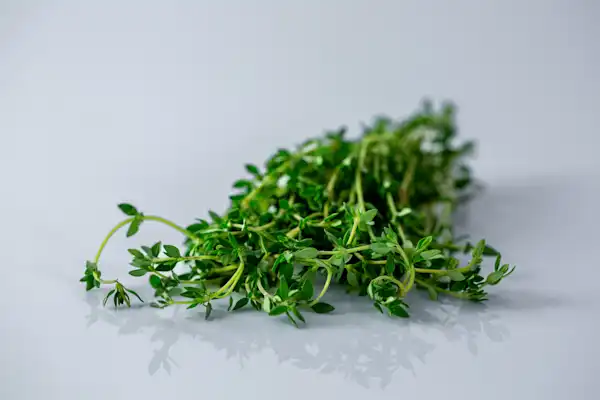Access our First Foods® Database in the Solid Starts App.
Learn moreThyme
Herb/Spice
Age Suggestion
6 months
Iron-Rich
No
Common Allergen
No

When can babies have thyme?
Thyme may be introduced as soon as baby is ready to start solids, which is generally around 6 months of age.
Thyme is an evergreen shrub from the lands around the Mediterranean Sea. Migration and trade introduced the herb around the globe, and today there are countless varieties to try. Some thyme grows high and bushy, while other varieties cover the ground with tiny pink, purple, or white flowers. Thyme’s flavor tends to be fresh and floral, with a distinctive aroma that is endlessly adaptable for meats, sauces, soups, stews, vegetables, and more.
How do you serve thyme to babies?
Every baby develops on their own timeline, and the suggestions on how to cut or prepare particular foods are generalizations for a broad audience.
6 months old +:
Finely chop fresh thyme and incorporate into age-appropriate dishes for baby, like a dressing for cooked vegetables or a sauce for meat. As long as the stem of the plant is soft, you can finely chop the stem along with the leaves. If the stem has gotten woody and tough, remove the leaves from the stem before preparing. Alternatively, use dried thyme or powdered thyme to flavor food.
12 months old +:
Use fresh, dried, or powdered thyme as you normally would in dishes, including whole fresh thyme leaves. If you’ve left a large, woody sprig of thyme in a dish to flavor it as it cooks, remember to remove it before serving to reduce the chance of discomfort or choking if it ends up in the toddler’s portion of the meal.
Videos
Is thyme a choking hazard for babies?
No. Thyme presents a low risk when safely prepared for a child’s age and developmental ability, though, in theory, an individual could choke on any food. To reduce the risk, prepare and serve thyme in an age-appropriate way as described in the How to Serve section. As always, make sure you create a safe eating environment and stay within an arm’s reach of baby during meals.
Learn the signs of choking and gagging and more about choking first aid in our free guides, Infant Rescue and Toddler Rescue.
Is thyme a common allergen?
No. Allergies to thyme are not common, but cases have been reported. If a child is sensitive to plants of the Lamiaceae family such as mint, oregano, basil, lavender, rosemary, sage, or marjoram, take care when introducing thyme, as these plants are closely related.
As you would when introducing any new food, start by offering a small quantity for the first few servings. If there is no adverse reaction, gradually increase the quantity over future meals.
Is thyme safe for babies?
Yes, thyme is generally recognized as safe in amounts typically used in cooking. Thyme essential oils should be avoided for baby, as their safety has not been sufficiently studied in children.
Is thyme healthy for babies?
Yes. Thyme offers small amounts of a variety of vitamins, minerals, and fiber. Thyme also contains a number of plant compounds like thymol and carvacrol, along with other phenols, flavonoids, and carotenoids, which may offer anti-inflammatory, antimicrobial, and antioxidant properties.
Do I need to start solids with purees?
You can if you’d like, but there's no developmental need to start with textureless food. Babies can be served modified versions of what you eat. Use our First Foods Database to find how to safely serve any food.
How many meals per day should baby eat?
It’s flexible. Generally speaking, bring baby to the table at least once per day between 6 and 7 months of age, twice per day between 8 and 9 months of age, and 3 times per day starting at around 10 months of age. See our sample feeding schedules for details.
Our Team
Written by
Expert Tips Delivered to Your Inbox
Sign up for weekly tips, recipes and more!





